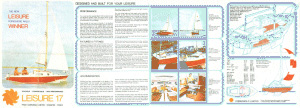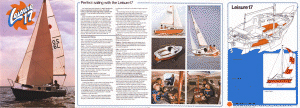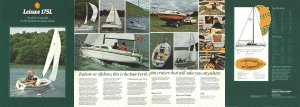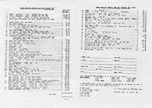The Leisure 17 is one of the most successful small yachts ever built. It normally has four berths, The hull is built in solid GRP and apart from the very earliest models, the cabin top and sides having GRP linings. This construction provides great strength and maximum insulation – In 1968, one of the first L17s crossed the Atlantic.
The Leisure 17 stands up well to her canvas, is light on the helm and a very easy boat to handle. Ideal for short-handed and family crews.
Cast iron fin or twin keel configurations are available, with the twin keel version having a high aspect ratio hydrofoil section.
Rudder and skeg are glassfibre with stainless steel framework and fittings. Auxiliary power is normally provided by a 4 or 5 hp long shaft outboard on a transom mounted bracket.
The spars are made of aluminium alloy, originally gold, the spars of later boats are black or silver. Halyards are internal. Standing rigging and rigging screws are in stainless steel.
Accommodation
The large self-draining cockpit has a transom locker for a gas bottle and storage for the outboard when not in use.
However, the larger four-stroke, long-shaft outboards of today may be difficult to fit in this locker.
The deck has moulded non-slip areas for safe working.
Down below, a four berth arrangement is standard, two in the fore peak and one either side in the main cabin that run down the whole length of the cabin. An alcohol or gas hob and grill is normally fitted under the companionway. Alternatively, a three berth arrangement is possible, with a large cockpit sail locker replacing one of the quarter berths.
Leisure 17SL
The original Leisure 17 was designed by Arthur Howard and subsequently gave way to the 17SL designed by Cobramold founder, Brian Meerloo. This has the same hull as the Leisure 17, but has a redesigned coach roof to give a more modern, wedge-shaped look.
Specification Detail
| Length Overall | 5.18 m | 17 ft |
| Length Waterline | 4.27 m | 14 ft |
| Beam | 2.13 m | 7 ft |
| Draft | ||
| Fin | 0.97 m | 3 ft 2 in |
| Twin | 0.65 m | 2 ft 2 in |
| Displacement | ||
| Fin | 727 kg | 1602 lbs |
| Twin | 670 kg | 1476 lbs |
| Keel mass | 250 kg | 550 lbs |
| Ballast Ratio | 37% | |
| Mast | 6.1 m | 20 ft |
| Mainsail | 7.7 m2 | 83 ft2 |
| Working Jib | 6 m2 | 65 ft2 |
| No.1 Jib | 7.9 m2 | 85 ft2 |
| No.1 Storm Jib | 3.7 m2 | 40 ft2 |
| Genoa | 9.3 m2 | 100 ft2 |
| No.1 Spinnaker | 19.3 m2 | 208 ft2 |
| No.2 Spinnaker | 13.9 m2 | 150 ft2 |
| 5 kg Bruce anchor | 14m of 6mm chain | 18m of warp |
| Engine | Outboard long shaft | 4 or 5 hp |
Leisure 17 Brochures
Typical Leisure 17SL Specification
by R. Russell
- Overview – A lightweight trailer-sailer with masthead rig. Four full-length berths. Twin keels and skeg mounted rudder.
- Construction – One piece (white) moulded GRP hull with cast-iron twin ballast keels and skeg mounted rudder which allows the boat to take to the ground safely. Shallow draught for easy launching and exploring shallow creeks. GRP deck moulding with non slip surface, encapsulated reinforced plywood pads beneath fittings. Hull-to-deck joints bonded with GRP and fitted with teak gunwales bolted through hull and deck joint.
- Accommodation – Internal GRP moulded, forming four full length settee berths/seating. Area lit by perspex windows both sides and forward, with vented cabin top. The mast support accommodates a height adjustable, pivoting table with fiddles. Under-berth stowage areas have loose ply covers supporting 3″ fabric covered tailored cushions. Backrests in matching 2″ fabric, Velcro-fixed to glove box type stowage space, with shelf over. Bulkheads trimmed in teak ply. The aft berths continue below cockpit.
- Cooking – Two burner hob with grill is situated centrally below the gangway and powered by gas stored in the aft locker.
- Toilet – Portable chemical toilet is located forward of the mast support in a GRP moulded stowage compartment, concealed beneath a matching fabric covered lift-off hood.
- Cockpit – Waterproof vinyl covered cushions. Self-draining sole with crossover outlets. Access to the cabin is forward and central via a sliding hatch and two loose washboards, one of which is vented. Spray dodgers protect the cockpit. A boom tent, fitted with side windows and integral blinds, attaches to the mast and guard rails. Depth sounder display and compass mounting are fitted. Mooring cleats are mounted on each rear quarter.
- Electrical System – Fed from a 12V, 44 amp/hr battery fitted in the externally vented aft locker. Wiring is led to the cabin via conduit to a key operated isolating switch. There is a fused 3-way supply and switched feeds to a radio/cassette, a depth sounder, twin cabin lighting with twin cigarette lighter socket outlets for accessories, VHF Handheld and GPS Handheld.
- Rigging – Aluminium mast and roller-reefing boom, stainless steel inner and outer shrouds with raked back spreaders, single forestay and split twin backstay. The mast contains four internal halyards each with its own cleat. The mainsheet is 4:1 to a traveller mounted aft of the cockpit. Optional roller furling headsail, sheets led via travellers to jamming cleats with integral fairleads.
- Guard-Rails – 7 x 19 stainless steel cables running between pushpit and pulpit rails supported by two further intermediate stanchions providing continuous protection. A link rail is provided aft centrally over the transom to assist boarding access.
- Anchor Locker – Self-draining and forward within pulpit area containing a 5 kg Bruce anchor, 14m of chain and 18m of warp, which can be fed through the bow roller/fairlead and attached to a central mooring cleat.
- Aft Locker – Full width/depth of transom contains 12V Battery, Camping Gaz bottle and vacuum lift fuel tank, vented externally and lockable via a warp led into the cabin with cam-cleat. Stowage also for fenders, warps, etc.
- Engine – 4 or 5 hp outboard mounted on folding transom bracket with an integral charging system. Morse remote controls are mounted on the starboard pulpit rail.
- Boarding ladder – Situated to the portside of the transom with a centre clip on guard rail to assist boarding access.
- Sails – Main, Genoa, Storm Jib and Spinnaker.
Performance
The Leisure 17 is quite often raced, with significant success in small cruiser classes. However, the only racing handicap information we have are Portsmouth Yardstick (PY), Secondary Yardstick (SY), various Recorded Numbers (RN) and Club Numbers (CN) as shown below.
For cruising boats, The RYA has updated the Portsmouth Yardstick scheme with the National Handicap for Cruisers (NHC).
More up to date information may be obtainable from the RYA NHC site and the Byron web site.
| Portsmouth, Secondary or Recorded number | ||||||
|---|---|---|---|---|---|---|
| Keel | Engine | Number Source/Year | ||||
| Twin | Outboard | PY1285 (2000) | SY1280 (1999) | RN1290 (1996) | RN1360 (1988) | PY1340 (1983) |
| Byron Software Club Number | ||||||
|---|---|---|---|---|---|---|
| Knots | Keel | Eng | Furl | uSAD | dSAD | ByCN |
| 5.02 | Fin | ob | 17.6 | 25.0 | 166 | |
| 5.02 | Twin | ob | rr | 15.5 | 26.5 | 1258 |








